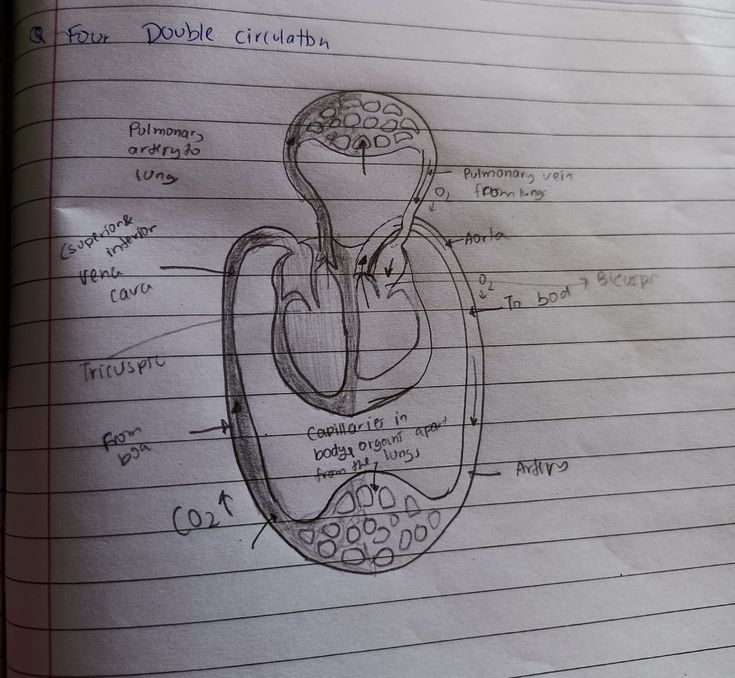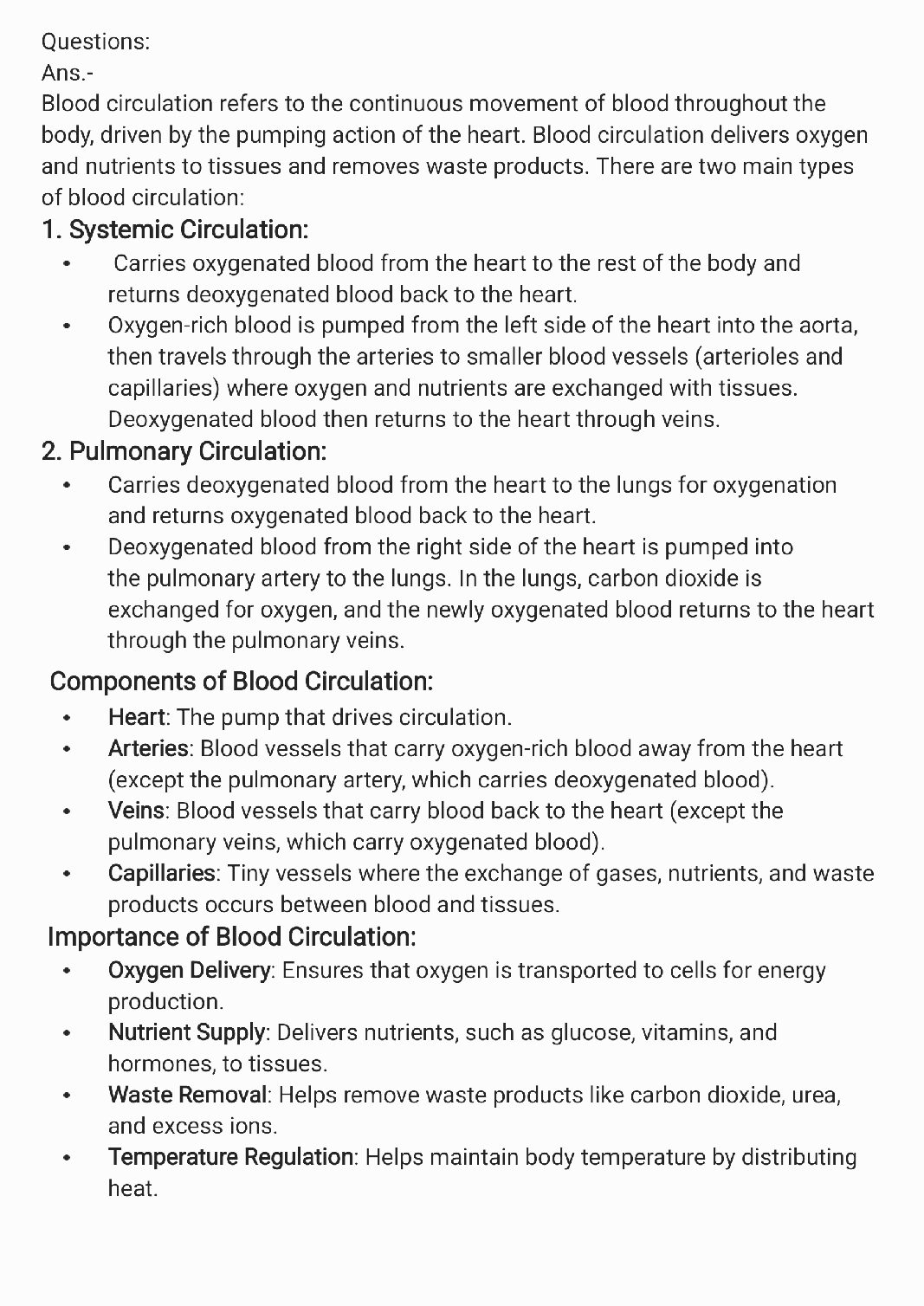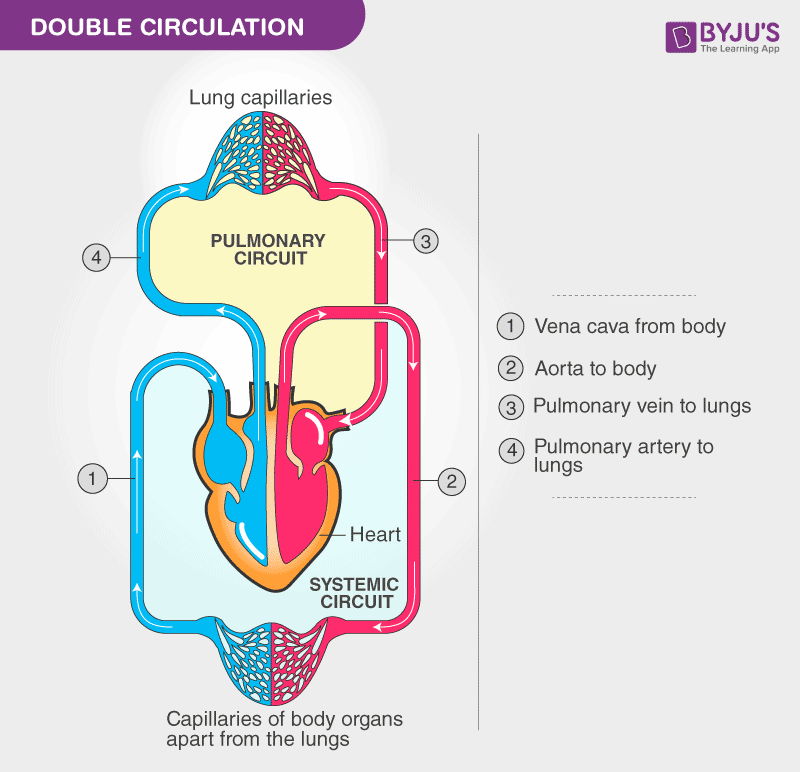explain double blood circulation in detail
Double circulation! Also known as dual circulation, it’s a fascinating process that ensures efficient oxygenation and nutrient delivery to the body’s tissues.
What is Double Circulation?
Double circulation refers to the two distinct circulatory pathways in the body:
1. *Pulmonary circulation*: Deoxygenated blood from the body flows to the lungs to pick up oxygen and release carbon dioxide.
2. *Systemic circulation*: Oxygenated blood from the lungs flows to the rest of the body, delivering oxygen and nutrients to tissues.
Pulmonary Circulation
1. *Deoxygenated blood*: Returns to the right atrium (upper chamber of the heart) through the superior and inferior vena cavae.
2. *Right atrium*: Blood flows into the right ventricle (lower chamber of the heart) through the tricuspid valve.
3. *Right ventricle*: Blood is pumped to the lungs through the pulmonary valve and pulmonary arteries.
4. *Lungs*: Oxygen is absorbed into the blood, and carbon dioxide is removed through the process of respiration.
5. *Oxygenated blood*: Returns to the left atrium through the pulmonary veins.
Systemic Circulation
1. *Oxygenated blood*: Flows from the left atrium into the left ventricle through the mitral valve.
2. *Left ventricle*: Blood is pumped to the rest of the body through the aortic valve and aorta (largest artery).
3. *Aorta*: Branches into smaller arteries, which distribute oxygenated blood to various organs and tissues.
4. *Capillaries*: Oxygen and nutrients diffuse into tissues, while waste products are collected.
5. *Deoxygenated blood*: Returns to the right atrium through the venous system, completing the double circulation loop.
Advantages of Double Circulation
1. *Efficient oxygenation*: Ensures that oxygen is delivered to tissues and carbon dioxide is removed.
2. *Increased blood pressure*: Allows for efficient blood flow to tissues and organs.
3. *Improved circulation*: Enables the body to respond to changing oxygen demands and maintain homeostasis.
Clinical Significance
1. *Heart failure*: Impaired cardiac function can lead to inadequate oxygen delivery and tissue damage.
2. *Respiratory diseases*: Conditions like COPD can affect gas exchange in the lungs, impacting double circulation.
3. *Vascular diseases*: Atherosclerosis, hypertension, and other vascular conditions can compromise blood flow and oxygen delivery.
In conclusion, double circulation is a vital process that ensures the efficient delivery of oxygen and nutrients to the body’s tissues. Understanding this process is essential for appreciating the complexities of human physiology and addressing various clinical conditions




Double blood circulation is a circulatory system where blood passes through the heart twice in one complete circuit. This system, found in birds and mammals, involves two separate pathways: pulmonary circulation (heart to lungs and back) and systemic circulation (heart to body and back). The heart’s four chambers facilitate this process, separating oxygenated and deoxygenated blood to ensure efficient oxygen delivery to the body.
Pulmonary Circulation:
1. Deoxygenated blood:
Deoxygenated blood from the body tissues enters the right atrium of the heart.
2. Right ventricle:
The right atrium contracts, pushing the deoxygenated blood into the right ventricle.
3. Pulmonary artery:
The right ventricle pumps the deoxygenated blood into the pulmonary artery, which transports it to the lungs.
4. Lungs:
In the lungs, blood exchanges carbon dioxide for oxygen, becoming oxygenated.
5. Pulmonary vein:
The oxygenated blood returns to the left atrium of the heart via the pulmonary vein.
Systemic Circulation:
1. Left ventricle:
The left atrium contracts, pushing the oxygenated blood into the left ventricle.
2. Aorta:
The left ventricle pumps the oxygenated blood into the aorta, the largest artery in the body.
3. Arteries:
The aorta branches into smaller arteries, delivering oxygenated blood to all parts of the body.
4. Capillaries:
At the capillaries, oxygen is released into the body tissues, and carbon dioxide is absorbed.
5. Veins:
Deoxygenated blood is collected by veins and returned to the right atrium of the heart.
Significance of Double Circulation:
Efficient Oxygen Delivery:
Separating oxygenated and deoxygenated blood ensures that oxygenated blood is delivered to the body tissues, supporting cellular respiration.
Maintaining Systemic Blood Pressure:
The heart’s double pumping action generates higher systemic blood pressure, which is necessary for efficient blood flow throughout the body.
Efficient Gas Exchange:
The pulmonary circulation allows for efficient gas exchange in the lungs, ensuring adequate oxygen levels in the blood.
Double circulation is a type of blood circulation found in humans and other mammals, where the blood passes through the heart twice during one complete cycle of the body.
It has two main parts:
1. Pulmonary circulation (Lungs):
• Deoxygenated blood from the right side of the heart is pumped to the lungs.
• In the lungs, blood gets oxygenated and releases carbon dioxide.
• The oxygen-rich blood returns to the left side of the heart.
2. Systemic circulation (Body):
• The left side of the heart pumps oxygenated blood to the rest of the body.
• The body uses up the oxygen and adds carbon dioxide to the blood.
• The deoxygenated blood returns to the right side of the heart.
Diagrammatic Summary:
• Right side of the heart → Lungs → Left side of the heart → Body → Right side again
Importance of Double Circulation:
• Ensures separation of oxygenated and deoxygenated blood.
• Maintains high blood pressure in the body tissues for efficient nutrient and gas exchange.
• Provides efficient oxygen supply to the body, supporting warm-blooded metabolism.